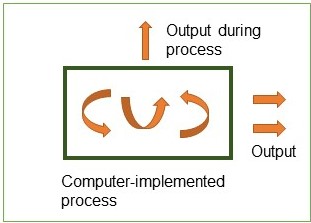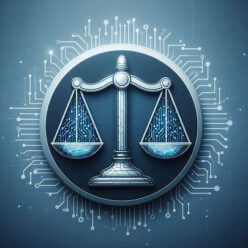The previous chapter (7) “Aspects of technicality of computer-implemented inventions” considered possible interactions between non-technical features and technical features in computer implemented inventions. This chapter discusses, inter alia, possible output interactions and interactions occurring within the computer. The question of whether data based on them can have a technical character and therefore be considered for inventive step is clarified. This information is based on the EBoA decision G1/19, points 89 to 96.
Interactions in computer implemented inventions
The figure below illustrates that this chapter deals mainly with interactions/ technical effects regarding technical output and adaptations to the computer or its operation (following the figure in chapter (7) regarding the interactions).

Such interactions/technical effects play a role in inventive step, see also chapter (3) “COMVIK approach”.
Potential effects of a computer program
Some of the amicus curiae briefs in G1/19 cited decision T 1173/97 (see chapter (9.1)) in support of the argument that it is sufficient for a computer-implemented invention to have the potential to produce a technical effect. That decision acknowledged that a computer program product may have the potential to cause a predetermined further technical effect, i.e. a technical effect going beyond the technical effects within the computer that necessarily occur when a program is run on a computer (Reasons, points 6 and 7). The claims underlying this decision included claims to a “computer program product directly loadable into the internal memory of a digital computer” and to a “computer program product stored on a computer usable medium”. The only question to be decided was whether these claims were excluded from patentability under Article 52(2) and (3) EPC (Reasons, point 9.1). In that context the board found that, since any (technical or non-technical) effect of a computer program can only be achieved when the program is run on a computer, a program only possesses the “potential” to produce any effect (Reasons, point 9.4). Nonetheless the board found that “[a] computer program product which (implicitly) comprises all the features of a patentable method” is “in principle considered as not being excluded from patentability under Article 52(2) and (3) EPC” (Reasons, point 9.6).

Software is treated as software running on a computer
The acknowledgment of a “potential” to produce an effect in T 1173/97 meant that the effect of a computer program when run on a computer had to be considered in the patentability analysis, or, in other words, that the condition “when run on a computer” was implied in the claim to a computer program product. Based on this conclusion, the case was remitted to the department of first instance for further prosecution, “in particular for examination of whether the wording of the present claims avoids exclusion from patentability under Article 52(2) and (3) EPC” (point 2 of the order).

The T 1173/97 did not address the question whether the claimed invention had technical character, but it made clear that the physical modifications deriving from the execution of the instructions given by the program could not per se constitute the technical character of the invention (Reasons, point 6.6).
Potential further technical effect
The principle developed in T 1173/97 that software (which in itself may only have “potential effects”) is treated as software running on a computer is still applied, while the further analysis (i.e. whether the software causes further technical effects) is now carried out according to the COMVIK approach.
When run on a computer, the combination of the claimed features must establish a technical invention. In the COMVIK analysis, the features have to be assessed as to their contribution to the technical character of the invention.
Decision T 1173/97 did distinguish between the effects produced by every computer program when run on a computer and the “further technical effect” possibly resulting from the running of the program on the computer (Reasons, point 9.4).

Of course, such “further technical effect” too may only be achieved when the program is running on the computer, i.e. the program may have the potential to cause such further technical effects which thus could be referred to as “potential further technical effects”.
Background: In the case of a genuine computer program claim, the physical changes occurring in the hardware when the program instructions are executed cannot per se establish technical character. This is because technical character cannot be derived solely from the features common to all computer programs. Otherwise, the prohibition of patenting would become completely meaningless. The technicality of the subject matter of a genuine computer program claim thus presupposes that the underlying teaching goes beyond the normal physical interaction of program and computer, see T 1173/97.
“Potential” technical effects always treated as “real” technical effects?
However, T 1173/97 did not establish whether the claimed computer program was related to any further technical effect but only made clear that a computer program product is not inevitably excluded from patentability (Reasons, point 12.2). In particular, the decision does not imply that, once the software is running on a computer, “potential” technical effects can always be treated as “real” technical effects for the purposes of the analysis according to the COMVIK approach.
This means, the T 1173/97 does not teach that potential further technical effects are considered regarding the COMVIK approach. The decision left this open.
Potential technical effect is an effect achieved in combination with non-claimed features
The decision T 0489/14 – referring decision of G1/19 – cites other decisions which have suggested “that a potential technical effect, i.e. an effect achieved only in combination with non-claimed features, can be taken into account in assessing inventive step” (Reasons, point 37).
Example (see also chapter (9.2)): In T 1351/04 – in the context of the COMVIK approach - a method for creating an index file and the resulting index file were considered to be technical means, since they determined the way the computer searched information, which search was a technical task (T 1351/04, Catchword and Reasons, point 7), see figure below. In other words: An index file containing management information to be used for searching a file – e.g. an Excel csv-file - and the method for producing the index file are technical means when they determine the way the computer searches information, which is a technical task. The management information e.g. includes starting positions of records in the csv-file.
This decision T 1351/04 referred to “functional data, intended for controlling a technical device”, which were “normally regarded as having technical character” (Reasons, point 7.2).

Further example: In T 110/90 (OJ EPO 1994, 557) the subject matter concerns control signals for a printer, which were considered technical features of the text-processing system in which they occurred (see Reasons, point 4).
Data intended for controlling a technical device
The appellant in G1/19 and the President of the EPO, and others too, referred to decision T 208/84 (VICOM, OJ EPO 1987, 14) – see chapter (9.3) – as another example of data processing being considered to have a technical effect. This case distinguished a method of digitally processing images from a mathematical method as such (Reasons, points 5 and 6).
Here, T 163/85 (OJ EPO 1990, 379) can also be mentioned, please see chapter (9.4). It concerned claims to a colour television signal adapted to generate a picture on specific television receivers. The deciding board found that the TV signal as claimed inherently comprised the technical features of the TV system in which it was being used (Reasons, point 2).
The older case law referred to above appears to confirm that data intended for controlling a technical device may be considered to have technical character because it has the potential to cause technical effects.
Data specifically adapted for intended technical use
The Enlarged Board of Appeal in G1/19 has now generalised this as follows:
In the context of the problem-solution approach and the COMVIK approach, such potential technical effects may be considered if the data resulting from a claimed process is specifically adapted for the purposes of its intended technical use. In such cases:
-
either the technical effect that would result from the intended use of the data could be considered “implied” by the claim, or
-
the intended use of the data (i.e. the use in connection with a technical device) could be considered to extend across substantially the whole scope of the claimed data processing method.
Data should not have relevant uses other than the use with a technical device
On the other hand, the arguments mentioned in the above paragraphs cannot be made if claimed data or data resulting from a claimed process has relevant uses other than the use with a technical device (such as for controlling a technical device). In this case, the analysis under Article 56 EPC may reveal that a technical effect is not achieved over substantially the whole scope of the claimed invention (see also chapter (6)).
Downstream effects
In the Enlarged Board’s view, the above-mentioned potential technical effects (which may be considered to be technical effects subject to certain conditions) have to be distinguished from the potential effects discussed in T 1173/97. The latter include all (technical and non-technical) effects resulting directly from the running of a program on a computer, i.e. effects occurring within the computer and relating to the hardware which executes the program. By contrast, the former are “downstream” effects which may or may not be caused by said data output.
Of course, numerical data output from a computer is a necessary pre-condition for any effects that are caused, and the “downstream effects” can be seen as a potential effect of the software.
However, the necessarily technical nature of some effects inside the computer does not mean that the “downstream” effects caused by the data output of the computer are necessarily of a technical nature. In T 1173/97 such effects – if considered as technical – were referred to as “further technical effects” (see Reasons, point 9.4).
Conclusions
According to T1173/97 the condition “when run on a computer” was implied in the claim to a computer program product. Furthermore, T1173/97 teaches that a computer program product is not inevitably excluded from patentability.
Further, in this chapter, information regarding a potential technical effect have been given. A potential technical effect is an effect achieved only in combination with non-claimed features. A potential technical effect can be taken into account in assessing inventive step and the COMVIK approach if the data resulting from a claimed process is specifically adapted for the purposes of its intended technical use.
